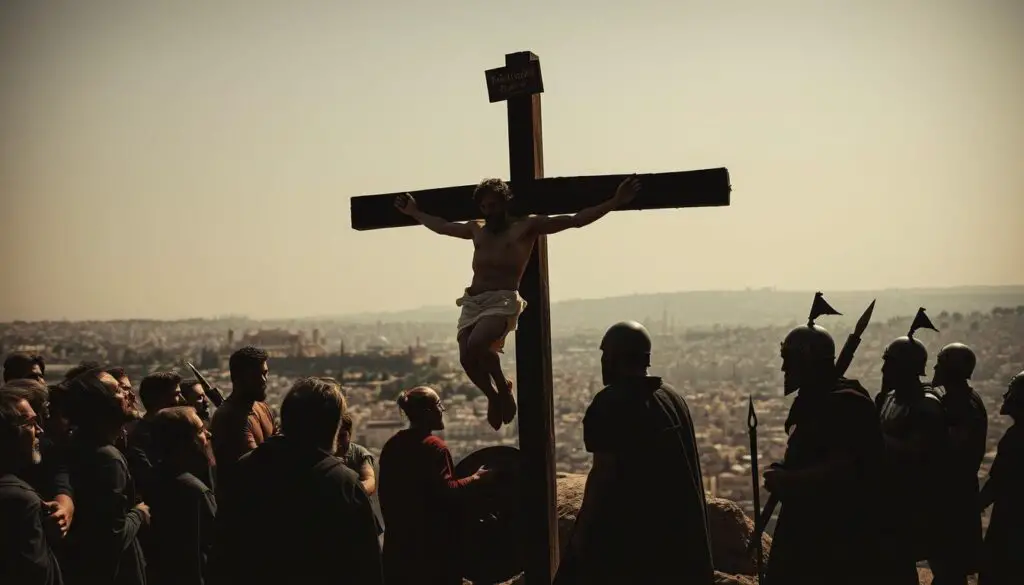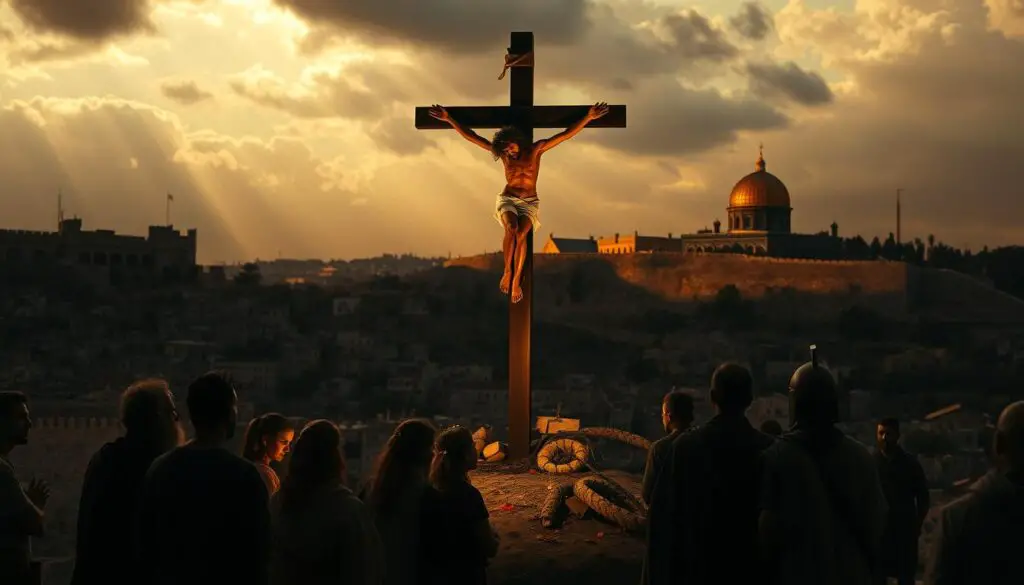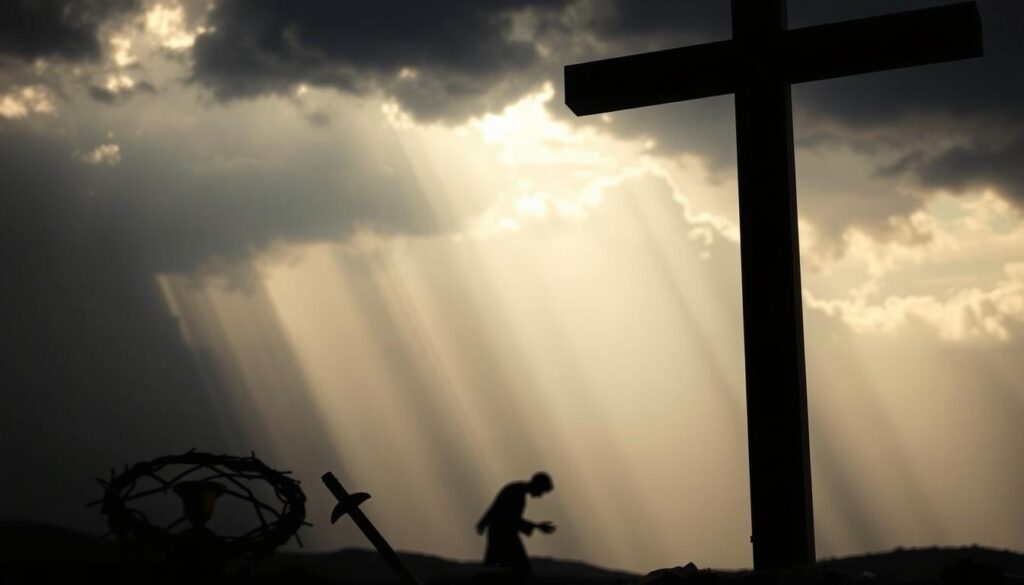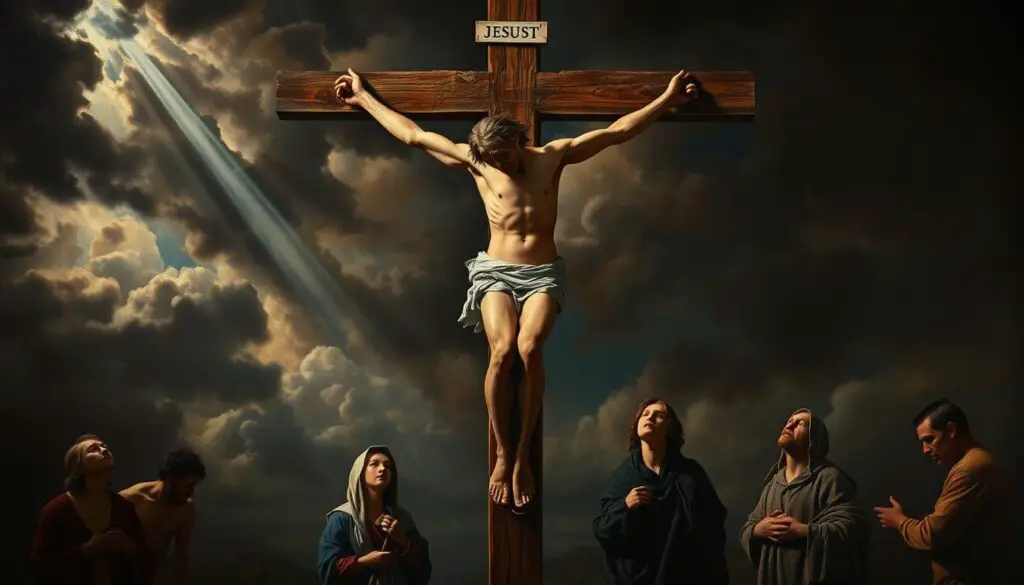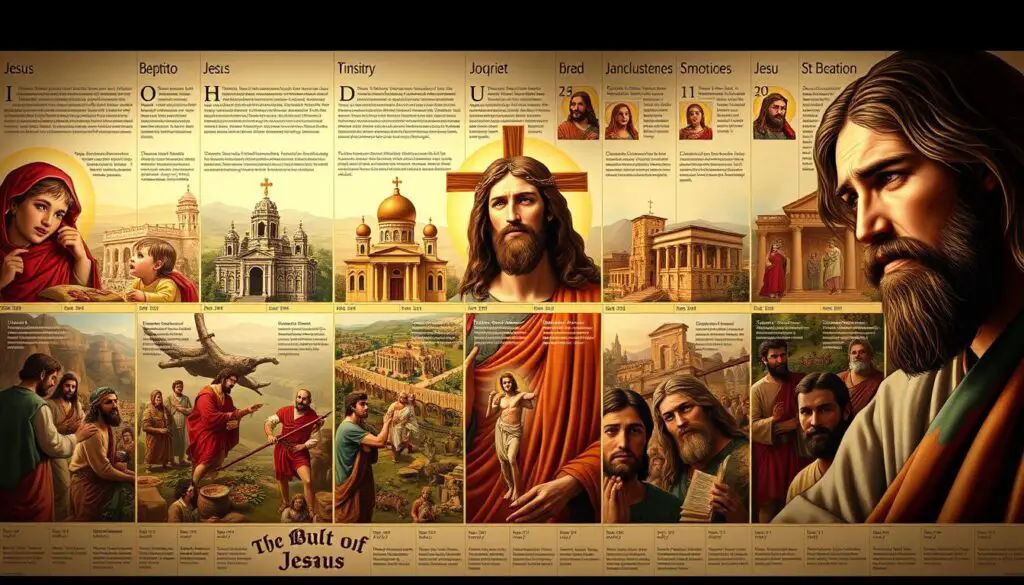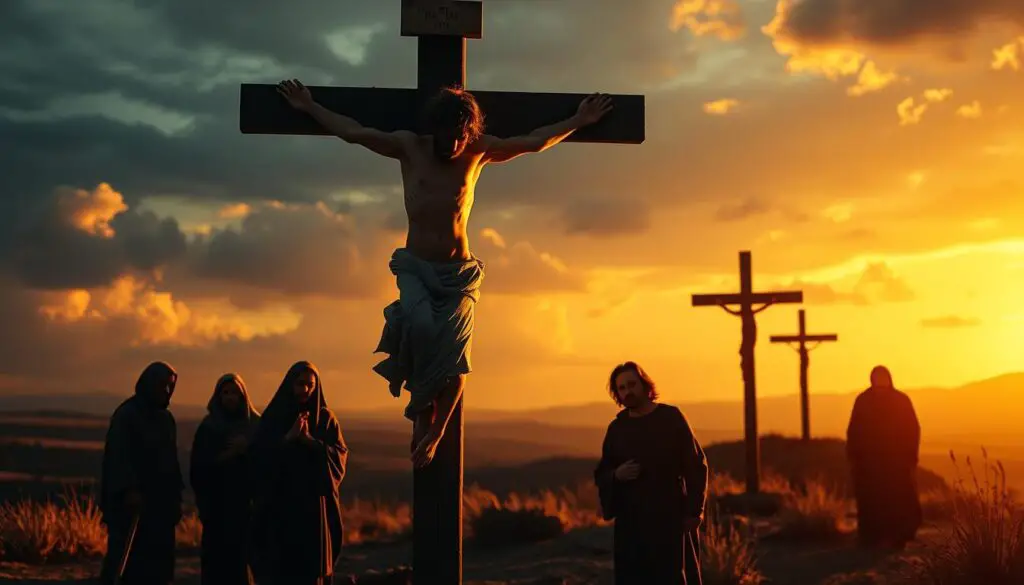The crucifixion of Jesus is a pivotal event in Christian faith, holding deep spiritual, historical, and cultural significance. It is through this act that Christians believe Jesus sacrificed himself for humanity’s redemption. The crucifixion, as described in the canonical gospels, was a brutal method of execution that involved nailing or binding the victim to a cross, leading to a slow and painful death.
According to historical accounts, Jesus was betrayed by Judas, one of his disciples, which led to his arrest. After a series of trials, including being brought before Pontius Pilate, Jesus was sentenced to death. The crucifixion process involved flogging, the placement of a crown of thorns on his head, and being nailed to a cross. This method of execution was common in ancient Rome, often used for political rebels and criminals.
The crucifixion of Jesus is not only a historical event but also a cornerstone of Christian theology. It symbolizes the ultimate act of love and sacrifice, offering forgiveness for humanity’s sins. The event is recorded in all four Gospels, emphasizing its importance in Christian tradition.
Key Takeaways
- The crucifixion of Jesus is central to Christian faith, symbolizing redemption and sacrifice.
- Crucifixion was a common Roman execution method, often used for political rebels.
- Jesus was betrayed by Judas, leading to his arrest and trials before Jewish and Roman authorities.
- The crucifixion involved flogging, wearing a crown of thorns, and being nailed to a cross.
- The event is recorded in all four Gospels, highlighting its theological significance.
Understanding the Context of the Crucifixion
To fully grasp the significance of the crucifixion, it’s essential to explore its spiritual and historical context. This event, deeply rooted in the 1st-century environment, was not just a religious act but also a political and cultural phenomenon.
Spiritual and Historical Background
The crucifixion of Jesus, as depicted in the gospel accounts, carries profound spiritual meaning. It symbolizes the ultimate sacrifice for humanity’s redemption. Historically, this practice was a common Roman execution method, often reserved for rebels and criminals. The public nature of crucifixions made them a tool for displaying Roman authority.
Cultural Significance of Crucifixion Practices
The role of Roman soldiers in executing the crucifixion was crucial. They followed orders, but their actions also carried cultural weight. To the Jewish community, crucifixion was a symbol of curse and humiliation, adding depth to the theological narrative.
Historical records from sources like Josephus and Tacitus provide a dual perspective—both as historical events and religious interpretations. These accounts highlight how cultural practices influenced the understanding of Jesus’ sacrificial act.
- The crucifixion occurred in a 1st-century context, reflecting Roman practices and Jewish sensitivities.
- Soldiers played a key role in executing the order, shaping cultural perceptions.
- Historical records and gospel narratives together offer a comprehensive view.
This blend of history and spirituality sets the stage for understanding the crucifixion’s enduring impact.
Historical Background of Jesus on the Cross
The crucifixion of Jesus is deeply rooted in the historical and cultural context of the 1st century. It was a time when Roman authority intersected with Jewish traditions, creating a complex backdrop for this pivotal event.
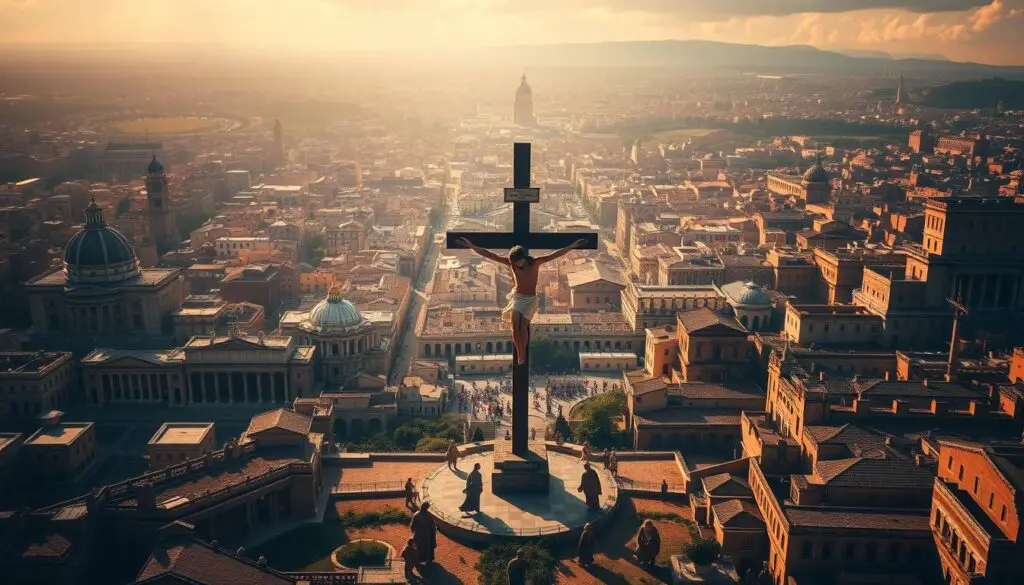
Understanding the historical setting requires examining both Roman and Jewish perspectives. The Roman Empire, under Pontius Pilate, used crucifixion as a method of execution, often for political dissidents. This practice was meant to deter others from challenging Roman authority.
Roman and Jewish Perspectives
The Roman legal system was systematic. Jesus was arrested, tried, and sentenced within a short period. The Jewish leadership, however, viewed Jesus as a threat to their religious and social order. This collaboration between Roman and Jewish authorities highlights the political and religious tensions of the time.
The crucifixion itself was a public spectacle. Jesus was on the cross for six hours, from 9 AM to 3 PM. During this time, he spoke seven last words, which are recorded in the Gospels. These words, such as “Father, forgive them” and “It is finished”, carry deep theological significance.
The Roman soldiers followed their procedures meticulously. They erected the cross, inscribed “King of the Jews” in three languages, and divided Jesus’ garments. The Jewish leaders, however, saw this as a humiliation, reflecting their own cultural and religious biases.
- The crucifixion occurred on a specific day, with events unfolding from the arrest to the burial within 24 hours.
- Roman legal practices emphasized public display and deterrence, while Jewish leaders focused on maintaining religious purity.
- Jesus’ words on the cross, such as “Today you will be with me in paradise”, resonate deeply in Christian theology.
- Historical accounts personify Jesus as both a leader and a sacrificial victim, fulfilling Old Testament prophecies.
- Scholars note both consistencies and differences in accounts from sources like Josephus and Tacitus.
These historical and theological elements together provide a comprehensive understanding of the crucifixion’s significance.
The Gospels’ Narratives of the Crucifixion
The New Testament provides a detailed account of the crucifixion through the four Gospels, each offering unique perspectives while sharing a common purpose.
Comparing the Canonical Accounts
Each author in the New Testament presents the crucifixion with distinct emphases. Matthew highlights the fulfillment of prophecy, while Mark focuses on Jesus’ actions and emotions. Luke, known for his attention to Jesus’ compassion, details interactions with those around Him. John, meanwhile, emphasizes Jesus’ divine nature and the fulfillment of His mission.
While the core events remain consistent, each Gospel’s style and focus reflect the author’s theological themes. For instance, Luke’s narrative often includes dialogues that underscore themes of forgiveness and salvation, such as Jesus’ prayer for His persecutors.
Harmonizing the Passion Story
Despite their differences, the Gospels collectively present a unified story of sacrifice and redemption. Each account contributes a unique part to the narrative, weaving together historical detail and theological depth. The Passion story, as portrayed in the New Testament, serves as the foundation of Christian belief, illustrating the triumph of love over sin and death.
For those seeking deeper understanding, exploring these Bible verses provides profound insights into the significance of the crucifixion.
An In-depth Look at the Passion of Christ
The Passion of Christ unfolds as a profound journey of sacrifice and transformation, capturing the emotional and spiritual depth of Jesus’ final hours. This pivotal event in Christian faith is not just a historical account but a deeply moving narrative that resonates with believers worldwide.
At the heart of the Passion is the symbolism of blood, which holds profound significance in the context of redemption and covenant. As described in Isaiah 53:4–12, the blood shed during the crucifixion represents the ultimate sacrifice for humanity’s sins. This sacred act embodies the essence of divine love and forgiveness, forming the cornerstone of Christian theology.
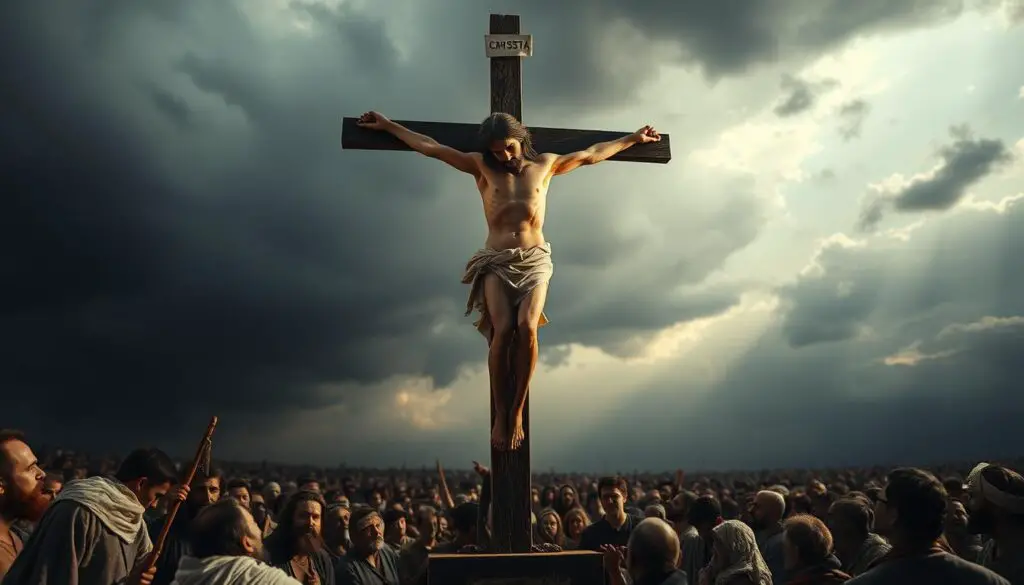
The final moments of Jesus’ life are marked by intense suffering, yet they also reveal remarkable spiritual strength. From the Last Supper to the crucifixion, each event is filled with emotional depth and theological meaning. His words and actions during this time continue to inspire reflection and devotion among Christians.
The Passion of Christ is more than just a historical event; it is a thing of profound meditation and faith. It bridges the gap between human frailty and divine grace, offering a message of hope and redemption. Through this sacred narrative, believers find comfort in the knowledge that His sacrifice was for the healing and salvation of all.
Crucifixion Details: Events at Golgotha
The crucifixion at Golgotha is meticulously documented in the four Gospels, providing a vivid timeline of events from the initial crucifixion to the final moments. This section delves into the key moments and their significance.
Timeline and Key Moments
The crucifixion began at 9:00 AM, as noted in Mark 15:25. Jesus was nailed to the cross, flanked by two criminals. The Roman soldiers, following procedure, divided His garments and placed a sign reading “King of the Jews” in three languages above Him.
Darkness descended from noon to 3:00 PM, as recorded in Matthew 27:45. During this period, Jesus uttered His final words, including the poignant “It is finished.” At 3:00 PM, He took His last breath, and the temple curtain tore in two, symbolizing the end of the old covenant.
| Time | Event | Significance |
|---|---|---|
| 9:00 AM | Crucifixion Begins | Marked the start of the crucifixion process. |
| 12:00 PM – 3:00 PM | Darkness Falls | Symbolized divine mourning and judgment. |
| 3:00 PM | Jesus’ Last Breath | Signified the completion of His sacrifice. |
| Post 3:00 PM | Temple Curtain Torn | Represented the end of the old covenant. |
The four Gospels present these events with slight variations, yet collectively they provide a comprehensive narrative. Matthew, Mark, Luke, and John each emphasize different aspects, but all converge on the central events.
Historically, these moments have been commemorated through Christian rituals, particularly during Holy Week. The timeline from crucifixion to resurrection underscores the theological foundation of Christianity, emphasizing redemption and divine love.
Significance of the Seven Last Words on the Cross
During His final hours on the cross, Jesus uttered seven profound statements that hold deep theological and liturgical significance. These words, recorded across the four Gospels, provide unique insights into His character and mission.
Thematic Analysis of Jesus’ Final Sayings
The first saying, “Father, forgive them; for they know not what they do,” emphasizes forgiveness and compassion. The second, “Today you will be with me in Paradise,” offers assurance of salvation to a repentant criminal. The third, “My God, my God, why have you forsaken me?” reflects a moment of spiritual separation, quoting Psalm 22. The fourth, “Woman, behold your son!” demonstrates care for His mother. The fifth, “I thirst,” highlights His humanity. The sixth, “It is finished,” signifies the completion of His mission. The seventh, “Father, into your hands I commend my spirit,” represents surrender and trust.
Theological Interpretations and Fulfillment of Prophecy
These final words fulfill Old Testament prophecies and emphasize themes of forgiveness, salvation, and divine love. The phrase “It is finished” (John 19:30) marks the fulfillment of His sacrificial act, making further animal sacrifices unnecessary. Each saying reflects Jesus’ role as Savior and the completion of His divine mission.
Impact on Christian Liturgy and Devotions
These seven last words have shaped Christian worship, particularly during Good Friday services. They are often used in sermons and liturgical practices, reminding believers of Jesus’ sacrifice and love. The phrases continue to inspire devotion and reflection, bridging the gap between human frailty and divine grace.
Art and Culture: Interpretations of the Crucifixion
The crucifixion has left an indelible mark on art and culture, inspiring countless works across various mediums. From religious iconography to literary masterpieces, this event continues to captivate creators and audiences alike.
Iconography in Religious Art
Religious art has long been a cornerstone of crucifixion depictions. Artists like Diego Velázquez and James Tissot have crafted iconic works that explore the event’s spiritual depth. Velázquez’s “Christ Crucified” stands out for its dramatic realism, while Tissot’s series offers a more intimate, emotional portrayal. These works often emphasize symbolic elements, such as the number of wounds or the positioning of hands, to convey deeper theological meanings.
![]()
Throughout history, the imagery of the cross has evolved, reflecting cultural and artistic trends. Early works focused on simplicity, while later pieces incorporated more intricate details, such as crowd reactions and celestial elements. This evolution highlights how the crucifixion’s message has been reinterpreted over time.
Literary and Musical Depictions
Literature and music have also drawn inspiration from the crucifixion. Works like “The Passion of Christ” by John Stainer use powerful melodies to recount the story, while literary pieces such as “The Dream of the Rood” offer poetic reflections. These depictions often focus on the emotional and symbolic aspects, using the cross as a metaphor for sacrifice and redemption.
In modern times, the crucifixion’s themes have influenced various genres. From classical compositions to contemporary art, the event’s universal message continues to resonate, making it a timeless subject in cultural expression.
Exploring jesus on the cross: Historical and Theological Insights
The crucifixion stands as a cornerstone of Christian theology, intertwining historical events with profound spiritual meaning. This section delves into the doctrine of atonement and salvation, exploring both historical insights and theological interpretations.
Doctrine of Atonement and Salvation
The execution of Jesus is widely viewed as a sacrificial act for humanity’s sins. This belief is rooted in theories like the Ransom Theory and Penal Substitution. These doctrines emphasize how His death on the cross symbolizes redemption, fulfilling Old Testament prophecies. The idea of substitutionary atonement, where Jesus bears punishment for humanity’s sins, is central to Penal Substitution Theory, supported by verses like Isaiah 53:5 and 2 Corinthians 5:21.

Theological Debates and Historical Evidence
Historical records and scholarly discourse provide a dual perspective on the crucifixion. While the Gospels narrate the event, historians like Josephus and Tacitus offer additional context. Debates persist about Jesus’ role as a willing sacrifice, with some viewing Him as a willing participant in redemption. The positioning of His feet during the execution holds symbolic meaning, reflecting theological interpretations of sacrifice and submission.
Examining historical accounts, both supporting and contrasting Gospel narratives, offers a comprehensive view. The crucifixion’s historical context, including Roman execution methods, underscores its significance. The event’s theological implications extend beyond history, shaping Christian beliefs about salvation and divine love.
The Role of Crucifixion in Early Christian Beliefs
The crucifixion became a cornerstone of early Christian theology, shaping beliefs and practices that continue to resonate today. This event was more than just a historical occurrence; it laid the foundation for understanding redemption and sacrifice.
The early Christian community deeply connected with the idea of suffering as a form of divine love. The body of Jesus, as described in the Gospels, symbolized the ultimate act of self-giving. This imagery became central to the development of Christian doctrines, emphasizing the idea of salvation through sacrifice.
- The crucifixion emphasized the theme of suffering as a transformative act, inspiring early believers to embrace martyrdom as a testament of faith.
- The depiction of the body on the cross symbolized the victory of love over death, becoming a powerful symbol for the early church.
- This event marked a turning point in Christian history, influencing rituals like the Eucharist and liturgical commemorations.
The early church saw the crucifixion as a pivotal moment that redefined their understanding of sacrifice and redemption. This event not only shaped their theology but also influenced their practices, creating a legacy that endures in Christian traditions today.
The Intersection of Religion and Politics in the Crucifixion Narrative
The crucifixion of Jesus was deeply intertwined with the political climate of the 1st century. This event, often seen through a religious lens, was also a strategic act shaped by the tensions between Roman authority and Jewish leadership. The Roman Empire, under Pontius Pilate, used crucifixion as a tool to maintain control and deter rebellion. This method of execution was typically reserved for political dissidents, not common criminals, highlighting the Roman soldiers’ role in upholding imperial authority.
Pilate and Imperial Authority in Context
Pilate’s decision to crucify Jesus was influenced by political pressures. The Roman governor faced a delicate balance between maintaining order and appeasing the Jewish populace. The involvement of Roman soldiers in executing the order underscores the imperial machinery at play. Their actions, though procedural, carried political weight, as they represented the face of Roman authority in a volatile region.
The gospel details reveal a narrative where political motivations intersect with religious beliefs. Jesus’ last words, such as “Father, forgive them”, resonate both as a religious plea and a statement that could be interpreted politically. These final acts and words were recorded with precision, emphasizing their dual significance in both religious and political contexts.
Today, these historical details continue to influence modern interpretations of the relationship between church and state. The crucifixion narrative serves as a timeless reminder of how religious and political dimensions can intertwine, shaping both theology and governance.
Impact of the Crucifixion on Christian Rituals and Traditions
The crucifixion has profoundly shaped Christian rituals, creating a legacy that resonates deeply in the hearts of believers. This event is not just a historical occurrence but a cornerstone of faith, influencing traditions that continue to evolve.
Holy Week Observances and Good Friday Practices
Holy Week serves as a solemn reminder of the crucifixion’s significance. Christians worldwide observe this period with reflection, prayer, and specific rituals. Good Friday, in particular, is a day of mourning, commemorating the sacrifice of the son who gave His life for humanity’s redemption. Many churches hold special services, often incorporating symbolic elements like the bone imagery from Scripture, which underscores the unbroken nature of His body, fulfilling prophecy.
Easter and Beyond: Continuing Traditions
Easter celebrations, while joyful, are deeply rooted in the crucifixion narrative. The resurrection symbolizes victory over death, a theme intertwined with the tradition of renewal. Beyond Easter, the crucifixion’s impact is evident in practices like the Eucharist, which reflects on the sacrifice. These rituals connect believers to the historical event, making it a living part of their faith. For deeper reflection, explore these Bible verses, which offer insights into the crucifixion’s enduring significance.
Interpreting Gospel Texts: Key Details and Debates
Scholars have long examined the Gospel accounts of the crucifixion, uncovering a rich tapestry of textual variants and interpretive debates. These discussions reveal how different city contexts and authorial choices shaped the narratives, offering unique insights into the event’s theological and historical dimensions.
Textual Variants and Scholarly Analysis
One notable debate centers on the “breaking of legs” episode. This event, recorded in John 19:31-37, has sparked discussion about its historical accuracy and symbolic meaning. The act of breaking legs was a Roman practice to hasten death, but its absence in other Gospels raises questions about its historical consistency.
Another area of study is how the city of Jerusalem’s political and religious climate influenced the crucifixion narrative. The Gospels reflect the tensions between Roman authority and Jewish leadership, with each account emphasizing different aspects based on their audience and context.
Scholars also explore how the broader world of 1st-century Judaism and early Christianity shaped these texts. The crucifixion narratives are not isolated events but are deeply connected to the cultural and religious milieu of their time.
- Scholars analyze how textual variants, like the “leg” breaking episode, impact the theological interpretation of the crucifixion.
- Different city contexts influenced the Gospels’ narratives, reflecting local traditions and audiences.
- The crucifixion accounts are part of a larger world of early Christian thought, connecting to themes of sacrifice and redemption.
These debates highlight the complexity and richness of the Gospel texts, offering a deeper understanding of the crucifixion’s significance within its historical and theological context.
Crucifixion in Art, Music, and Literature
The crucifixion has inspired countless works of art, music, and literature over the centuries. This event has been interpreted in various forms, each capturing its deep emotional and spiritual significance. From visual masterpieces to musical compositions, the crucifixion continues to be a timeless subject of creative expression.
Visual Representations Through the Ages
Artists have long been drawn to the crucifixion’s dramatic and symbolic nature. Works like Diego Velázquez’s Christ Crucified and James Tissot’s detailed series offer powerful visual narratives. These pieces engage the viewer’s eye, drawing attention to the emotional depth of the scene. The use of light, shadow, and composition emphasizes the theological and human aspects of the event.
Early icons and Renaissance masterpieces show a clear evolution in style and interpretation. While some works focus on the suffering, others highlight the divine nature of the sacrifice. This evolution reflects changing cultural and theological perspectives over time.
Musical Settings and Inspirational Works
Music has also played a significant role in interpreting the crucifixion. Composers like John Stainer have created powerful works based on the seven last words. These musical settings evoke a deep sense of reflection and emotion, connecting listeners to the event’s spiritual essence.
Literary works, such as The Dream of the Rood, offer poetic reflections on the crucifixion. These works often use the cross as a metaphor for sacrifice and redemption, bridging the gap between historical fact and theological insight.
| Form | Artist/Composer | Work | Significance |
|---|---|---|---|
| Painting | Diego Velázquez | Christ Crucified | Dramatic realism and emotional depth |
| Music | John Stainer | The Crucifixion | Musical interpretation of the seven last words |
| Literature | Anonymous | The Dream of the Rood | Symbolism of the cross |
These creative interpretations highlight how the crucifixion continues to inspire artists, musicians, and writers. By engaging with these works, we gain a deeper understanding of the event’s historical and theological significance.
Conclusion
The crucifixion narrative serves as a profound book of faith, weaving together history, culture, and theology. It is through this sacred account that we find the heart of Christian belief.
The role of the disciple has been crucial in preserving these stories. Their dedication ensures that the message of love and sacrifice endures through generations.
Even simple elements, like a garment, carry deep spiritual meaning. This attention to detail invites us to reflect on the richness of the narrative.
As we conclude, let us embrace the invitation to explore further. The crucifixion’s impact on individual faith and the broader Christian community is a story worth continuing to uncover.
FAQ
What is the significance of the crucifixion in the New Testament?
The crucifixion is central to Christian belief, symbolizing the ultimate sacrifice for humanity’s sin. It represents Jesus’ obedience to God’s will and the fulfillment of prophecy, as described in the four Gospels.
How did the Roman soldiers carry out the crucifixion?
Roman soldiers executed crucifixion by nailing the victim’s hands and feet to a cross. This act was a public display of execution, intended to deter others from committing similar offenses under Roman law.
What were Jesus’ last words on the cross?
According to the Gospels, Jesus’ last words included phrases like “Father, forgive them” and “It is finished.” These statements carry deep theological meaning and are often reflected in Christian liturgy.
How accurate are the biblical accounts of the crucifixion?
The accounts in the four Gospels provide detailed descriptions of the event. While scholars debate certain details, the core narrative remains consistent, supported by historical records of Roman execution practices.
Why was the crucifixion necessary, according to Christian theology?
The crucifixion is seen as a divine act of love, where Jesus took upon himself the punishment for humanity’s sin. This sacrifice is believed to restore humanity’s relationship with God, fulfilling the doctrine of atonement.
How did the crucifixion influence early Christian beliefs and practices?
The crucifixion shaped early Christian teachings on salvation and forgiveness. It became a cornerstone of faith, inspiring rituals such as the Eucharist and influencing the development of Holy Week traditions.
What role did Pontius Pilate play in the crucifixion?
As the Roman governor, Pilate sentenced Jesus to death by crucifixion. His decision, influenced by political pressure, highlights the intersection of religious and governmental authority in the narrative.
How is the crucifixion depicted in art and literature?
The crucifixion has been a recurring theme in religious art, music, and literature. It is often portrayed as a symbol of sacrifice and redemption, inspiring works from medieval hymns to modern compositions.
What does the crucifixion mean for Christians today?
For Christians, the crucifixion represents God’s love and the promise of salvation. It continues to inspire devotion, prayer, and reflection, particularly during Easter and Good Friday observances.








